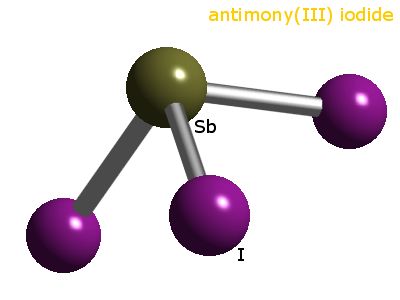Antimony triiodide
- Formula: SbI3
- Hill system formula: I3Sb1
- CAS registry number: [7790-44-5]
- Formula weight: 502.473
- Class: iodide
- Colour: red
- Appearance: crystalline solid
- Melting point: 170.5°C
- Boiling point: 401°C
- Density: 4920 kg m-3
The following are some synonyms of antimony triiodide:
- antimony triiodide
- antimony(III) iodide
- antimony iodide
The oxidation number of antimony in antimony triiodide is 3.
Synthesis
2Sb + 3I2 → 2SbI3
Antimony(III) triiodide forms in the direct reaction between the elements but the reaction is very violent. The reaction is much more controlled when iodine is added to a boiling suspension of antimony powder in benzene. The product antimony(III) triiodide crystallizes directly out of the reaction mixture as red crystals. The yield is about 80%. Antimony (III) triiodide is red and melts at 166°C. Its boiling point is 400°C. It hydrolyses rapidly in water.
Solid state structure
- Geometry of antimony:
- Prototypical structure:

Element analysis
The table shows element percentages for SbI3 (antimony triiodide).
| Element | % |
|---|---|
| I | 75.77 |
| Sb | 24.23 |
Isotope pattern for SbI3
The chart below shows the calculated isotope pattern for the formula SbI3 with the most intense ion set to 100%.
References
The data on these compounds pages are assembled and adapted from the primary literature and several other sources including the following.
- R.T. Sanderson in Chemical Periodicity, Reinhold, New York, USA, 1960.
- N.N. Greenwood and A. Earnshaw in Chemistry of the Elements, 2nd edition, Butterworth, UK, 1997.
- F.A. Cotton, G. Wilkinson, C.A. Murillo, and M. Bochmann, in Advanced Inorganic Chemistry, John Wiley & Sons, 1999.
- A.F. Trotman-Dickenson, (ed.) in Comprehensive Inorganic Chemistry, Pergamon, Oxford, UK, 1973.
- R.W.G. Wyckoff, in Crystal Structures, volume 1, Interscience, John Wiley & Sons, 1963.
- A.R.West in Basic solid state chemistry Chemistry, John Wiley & Sons, 1999.
- A.F. Wells in Structural inorganic chemistry, 4th edition, Oxford, UK, 1975.
- J.D.H. Donnay, (ed.) in Crystal data determinative tables, ACA monograph number 5, American Crystallographic Association, USA, 1963.
- D.R. Lide, (ed.) in Chemical Rubber Company handbook of chemistry and physics, CRC Press, Boca Raton, Florida, USA, 77th edition, 1996.
- J.W. Mellor in A comprehensive treatise on inorganic and theoretical chemistry, volumes 1-16, Longmans, London, UK, 1922-1937.
- J.E. Macintyre (ed.) in Dictionary of inorganic compounds, volumes 1-3, Chapman & Hall, London, UK, 1992.
